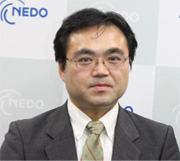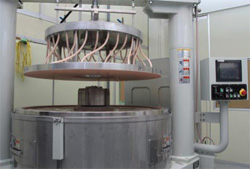Home > Highlighting JAPAN > Highlighting Japan JANUARY 2012 > A Rare Talent for Substitute Materials
Highlighting JAPAN
COVER STORY: Tomorrow's World
A Rare Talent for Substitute Materials
Many of the technologies in which Japan is a world leader are fields using rare metals like dysprosium, neodymium, and indium; for example, hybrid vehicles, electric vehicles, LCD TVs, personal computers, cameras and mobile phones. However, in recent years, the stable procurement of rare metals has grown difficult. Dr. Hiroaki Kurihara of the New Energy and Industrial Technology Development Organization (NEDO) plays a key role in the Rare Metal Substitute Materials Development Project, launched in 2007 to establish rare metal substitute materials and technologies to reduce rare metal consumption. Masaki Uno asked him about his work.

Dr. Hiroaki Kurihara of the New Energy and Industrial Technology Development Organization
Credit: MASAKI UNO
Typical examples of rare metals include dysprosium (Dy) and neodymium (Nd), which are used in the high-performance motors of products such as hybrid vehicles; indium (In), which is needed to manufacture the transparent electrodes in LCD TVs; and cerium (Ce), which is used to polish high-precision glass.
Japan's Achilles heel when it comes to securing such rare metals is that it is dependent on specific countries for supply of many of its materials. Overdependence on a single country can lead to shortages of materials and high prices if that country decides to impose export limits. For instance, the price of dysprosium increased about twenty-three times and that of cerium about seventeen times in the one and a half years from January 2010 to July 2011.
On assumption of such conditions, in 2006, METI adopted four policies: securing overseas resources, promoting recycling, developing substitute materials, and stockpiling rare metals. The organization charged with achieving the objective of developing alternative materials is the New Energy and Industrial Technology Development Organization (NEDO).

Glass polishing machine used in the Rare Metal Substitute Materials Development Project. The machine sandwiches glass between two rotating polishing pads, enabling both surfaces to be polished simultaneously.
Credit: COURTESY OF NEDO
NEDO's Dr. Hiroaki Kurihara, who is involved in the project, explains:
"We first conducted risk investigation and then selected high-risk elements. As a result, we selected ores such as indium, dysprosium, cerium and terbium. We target to finish research to put the results into practical use in five years. We are pursuing the project all the while responding to changes such as an increase in budget and the addition of new ores. For example, the cerium project produced results after about two and a half years. Generally speaking, projects are progressing ahead of schedule."
As for cerium, the project succeeded in halving consumption of the polishing agent cerium oxide (CeO2). A porous urethane resin-polishing pad and polishing agent made of cerium oxide are usually used to polish glass for LCD TVs and hard disks. In the project, researchers developed an epoxy resin pad with double the polishing efficiency of a urethane resin pad.
Dr. Kurihara says, "It was thought that because epoxy resin is normally hard, it does not lend itself to use for polishing pads. So our researchers optimized the resin type, its hardness and the amount of air bubbles in it, enabling its use as a polishing pad."
The research also revealed that zirconia (ZrO2) and manganese oxide (Mn2O3), which have stable supply conditions, can be used as substitute materials for cerium oxide. Thus, rapid progress is being made in research to establish cerium substitute materials technologies and technologies to reduce cerium consumption, and these technologies are expected to be commercialized in 2012.
Dr. Kurihara says, "Currently, research laboratories have succeeded in reducing consumption of indium and dysprosium by 45% and 40%, respectively. Our next challenge is to lead the research results to mass production technology."
"Establishing rare metal substitute materials technologies and technologies to reduce rare metal consumption is crucial for the future of Japan's industries. And surely, in terms of securing the stable supply of products, this is beneficial not only for Japan, but also for the entire world."
© 2009 Cabinet Office, Government of Japan






